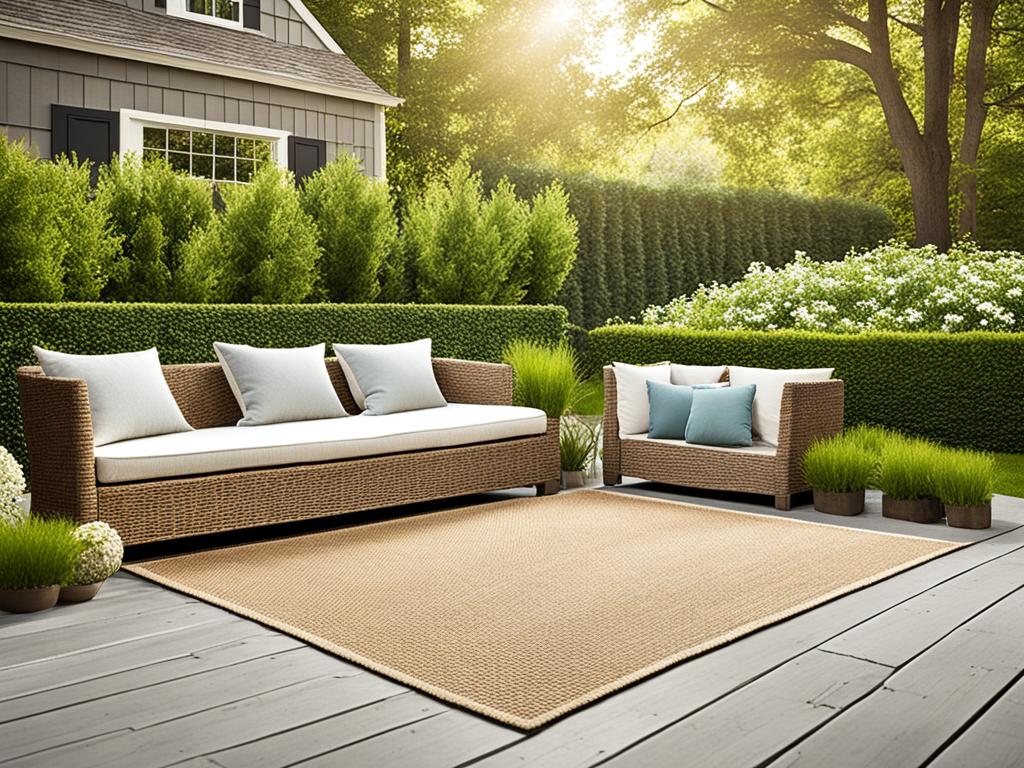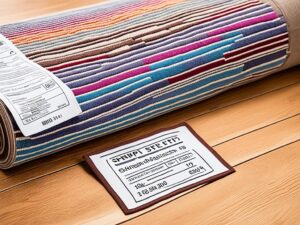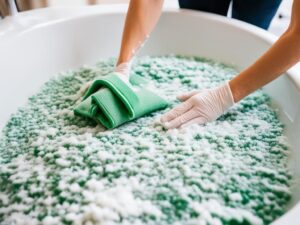Jute rugs are a popular choice for indoor spaces due to their soft texture and earthy tones. But can they be used outdoors? Let’s explore if jute rugs are suitable for outdoor use and the factors to consider.
Key Takeaways:
- Jute rugs should be used outdoors in covered areas or under a roof to protect them from rain and excessive moisture.
- Avoid placing jute rugs in direct sunlight to prevent fading.
- Jute rugs are not recommended for areas exposed to high humidity or rain, but they can be used in covered outdoor spaces or in dry climates.
- Alternative natural fiber rugs like seagrass and sisal are more suitable for wet environments.
- Regular cleaning and immediate attention to spills are essential for maintaining the durability of jute rugs.
Why jute and humidity don’t mix well
Jute rugs are made from strands of the jute plant, which grows in humid climates. However, jute rugs themselves are not well-suited for moist conditions. The natural fibers of jute are prone to mold and mildew when exposed to moisture, leading to the breakdown and faster wear of the rug. Additionally, outdoor stains like mud can be harder to clean off jute, as steam cleaning can damage the rug’s integrity.
Jute rugs require proper care and maintenance to ensure their durability outdoors. While they offer a natural and warm aesthetic, their vulnerability to high humidity and moisture should be considered when deciding to use them as outdoor rugs. To prolong the lifespan of the rug and maintain its appearance, it is essential to keep it away from areas with direct exposure to rain or excessive humidity.
“The natural fibers of jute can be compromised by moisture, leading to mold and mildew issues.”
In the next section, we will explore the perfect outdoor locations for jute rugs where they can be used to add style and comfort.
Perfect outdoor locations for jute rugs
While jute rugs are not recommended for pool areas or dense gardens, they can be used in outdoor spaces that are covered or have an overhead fan. Placing a jute rug in a covered patio or a screened-in lanai can protect it from rain and excess moisture. The softness of jute makes it perfect for covered areas meant for relaxation. Additionally, jute rugs are ideal for use in naturally dry climates that experience low humidity and minimal rainfall.
In covered outdoor areas, a jute rug can create a cozy and inviting atmosphere to enhance your patio or outdoor seating area. It adds a touch of warmth and natural texture, making it a popular choice for those who want to bring the indoors outside. Whether you have a covered porch, a gazebo, or a veranda, a jute rug can transform the space into a comfortable and stylish oasis.
If you have a screened-in lanai, you can enjoy the benefits of an outdoor rug without worrying about excessive moisture. The jute rug adds a layer of comfort underfoot, creating a serene and inviting space. It complements the outdoor ambiance while providing a gentle touch that makes your lanai feel like an extension of your indoor living area.
Jute rugs are also suitable for outdoor spaces in naturally dry climates. If you live in a region with low humidity and minimal rainfall, a jute rug can thrive in these conditions. It retains its softness and durability, offering the perfect blend of style and functionality for your patio, deck, or balcony.
Benefits of Jute Rugs in Outdoor Spaces
“Jute rugs add a touch of natural warmth and style to outdoor settings. Their soft texture and earthy tones create a cozy and inviting ambiance for covered areas. Additionally, jute rugs are eco-friendly and affordable, making them a popular choice for outdoor enthusiasts.”
Overall, while jute rugs may not be suitable for all outdoor environments, they are a versatile option for covered areas or locations with low humidity and minimal rainfall. Their natural charm and softness can enhance your patio, deck, or screened-in lanai, creating an outdoor retreat that blends seamlessly with your indoor decor.
Jute alternatives for outdoors
If jute rugs are not suitable for your outdoor setup, there are alternative natural fiber rug options to consider. These alternatives offer similar aesthetic appeal and durability for outdoor spaces:
1. Seagrass Rugs
Seagrass rugs are highly durable and can handle wet environments, as they repel water and stains. They are a great choice for outdoor areas that are prone to moisture or are exposed to rain. Seagrass rugs have a natural, beachy look that complements various outdoor settings.
2. Sisal Rugs
Sisal rugs, made from polypropylene, have a similar texture to jute and are better suited for outdoor use. They are resistant to moisture and fading, making them a durable option for outdoor settings. Sisal rugs come in a variety of patterns and colors, allowing you to find the perfect fit for your outdoor space.
3. Outdoor Wool Rugs
Outdoor wool rugs made from polysilk are mold and mildew resistant, making them suitable for humid climates. They provide a soft and cozy feel while maintaining their durability and resistance to outdoor elements. Outdoor wool rugs are available in various designs and sizes, ensuring there is an option to suit your outdoor style.
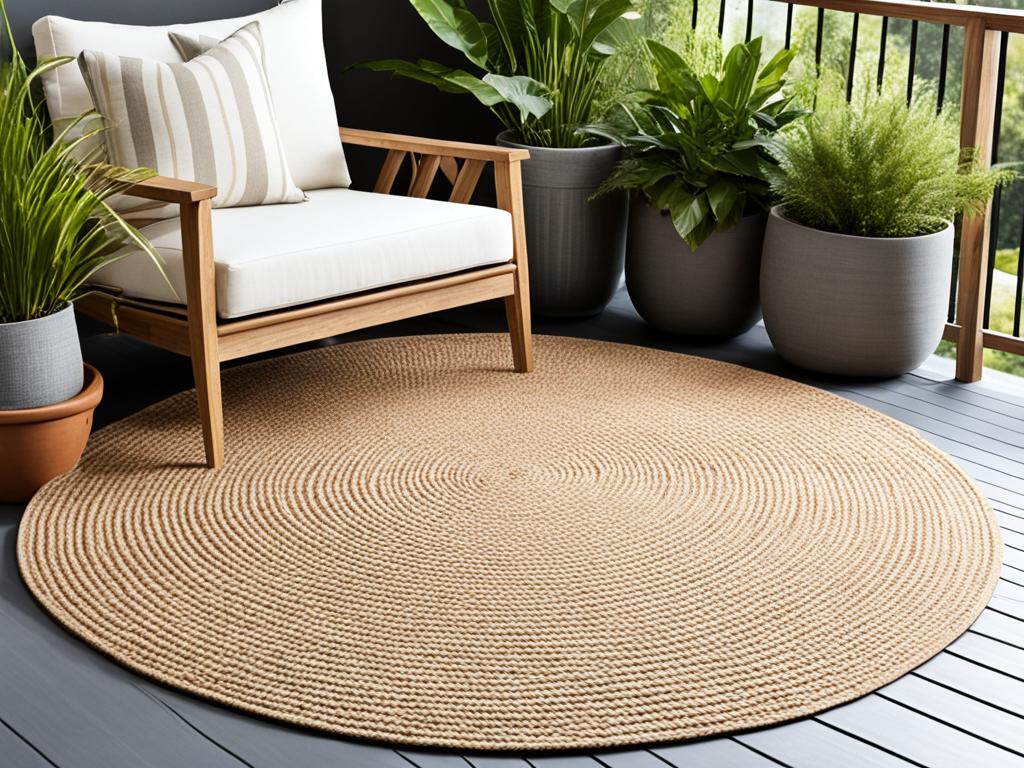
| Rug Type | Pros |
|---|---|
| Seagrass Rugs | – Highly durable – Water and stain-resistant – Natural beachy look |
| Sisal Rugs | – Similar texture to jute – Moisture and fade-resistant – Wide range of patterns and colors |
| Outdoor Wool Rugs | – Mold and mildew resistant – Soft and cozy feel – Available in various designs and sizes |
Advantages of jute rugs
Jute rugs offer numerous advantages that make them a desirable choice for both indoor and outdoor spaces. These eco-friendly rugs are not only affordable but also provide a unique combination of durability, aesthetic appeal, and versatility.
“Jute rugs are not only environmentally conscious but also a practical investment for homeowners looking to enhance their living spaces.”
Affordable and Eco-friendly
Jute rugs are made from natural and biodegradable materials, making them an eco-friendly choice. They are derived from the jute plant, a sustainable and renewable resource that requires minimal water and pesticide use during cultivation. Additionally, jute rugs are relatively more affordable compared to other natural fiber rugs, making them accessible to a wide range of budgets.
Durability and Woven Construction
One of the key advantages of jute rugs is their durability. Jute fibers are tightly woven together, creating a sturdy and resilient rug that can withstand high traffic areas. This makes jute rugs suitable for both indoor and outdoor spaces, providing long-lasting beauty and functionality.
Soft Texture and Natural Warmth
Jute rugs have a soft and pleasing texture that adds a touch of natural warmth to any space. Their earthy tones and intricate woven patterns create a cozy and inviting atmosphere, making them popular choices for living rooms, bedrooms, and patio areas. The natural fibers of jute rugs provide a comfortable and gentle surface underfoot, enhancing the overall comfort and aesthetics of the room.
Proper Maintenance and Considerations
While jute rugs offer many advantages, it is important to understand their susceptibility to moisture. To ensure their longevity and performance, jute rugs should be kept away from areas exposed to high humidity or rain, as moisture can lead to mold, mildew, and deterioration. Regular vacuuming and gentle spot cleaning are recommended for maintaining the cleanliness and appearance of jute rugs.
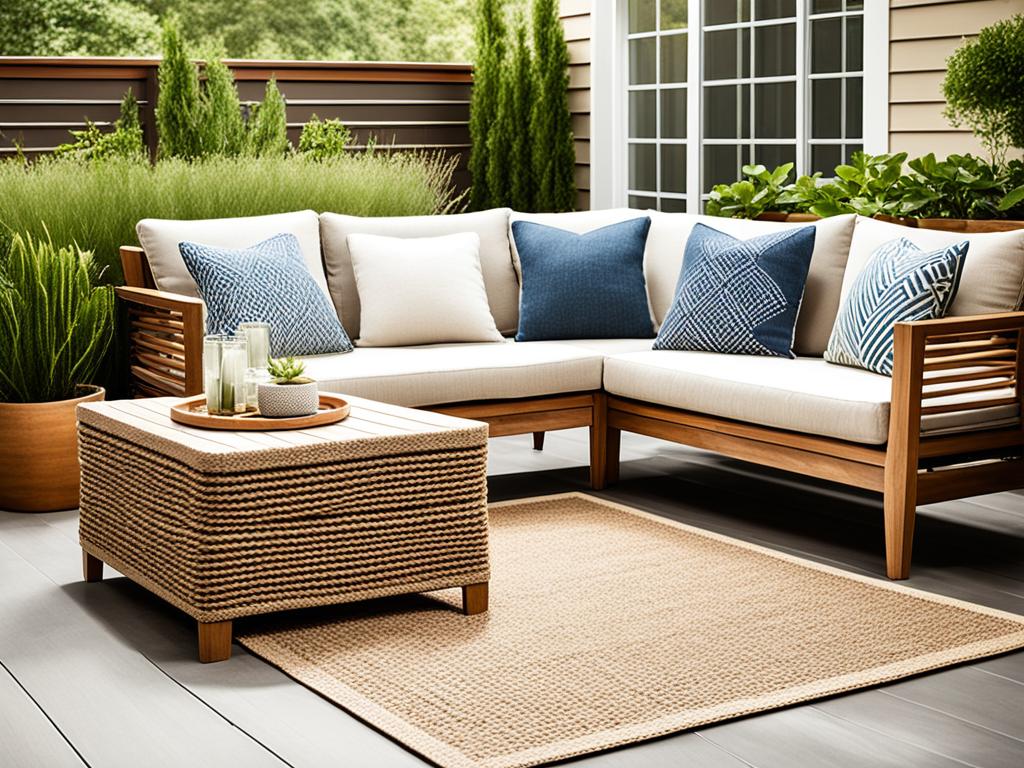
| Advantages of Jute Rugs |
|---|
| Affordable and eco-friendly |
| Durable and woven construction |
| Soft texture and natural warmth |
| Proper maintenance and considerations |
Can jute rugs be used outdoors?
Yes, jute rugs can be used outdoors, but it’s important to take proper precautions to ensure their durability and longevity. When considering using a jute rug in an outdoor setting, placement and maintenance are key.
To protect your jute rug from rain and excessive moisture, it should be placed in covered areas or under a roof. This will prevent the rug from coming into direct contact with water, which can lead to mold, mildew, and deterioration. Additionally, avoid placing jute rugs in direct sunlight for prolonged periods, as this can cause fading.
Cleaning and maintenance are essential to keep your outdoor jute rug in good condition. Regularly vacuum the rug to remove dirt and debris, and promptly attend to spills to prevent stains. If needed, you can spot clean the rug with a mild soap and water solution, but make sure to dry it thoroughly afterwards to prevent moisture buildup.
While jute rugs require a bit more care when used outdoors, they can add a natural and rustic aesthetic to your outdoor spaces. The earthy tones and woven texture of jute rugs create a warm and inviting atmosphere, perfect for outdoor relaxation areas or covered patios.
Keep in mind that jute rugs may not be suitable for all outdoor settings. If your area is prone to high humidity, heavy rain, or frequent exposure to moisture, it may be better to consider alternative natural fiber rugs such as seagrass or sisal, which are more resistant to water and stains.
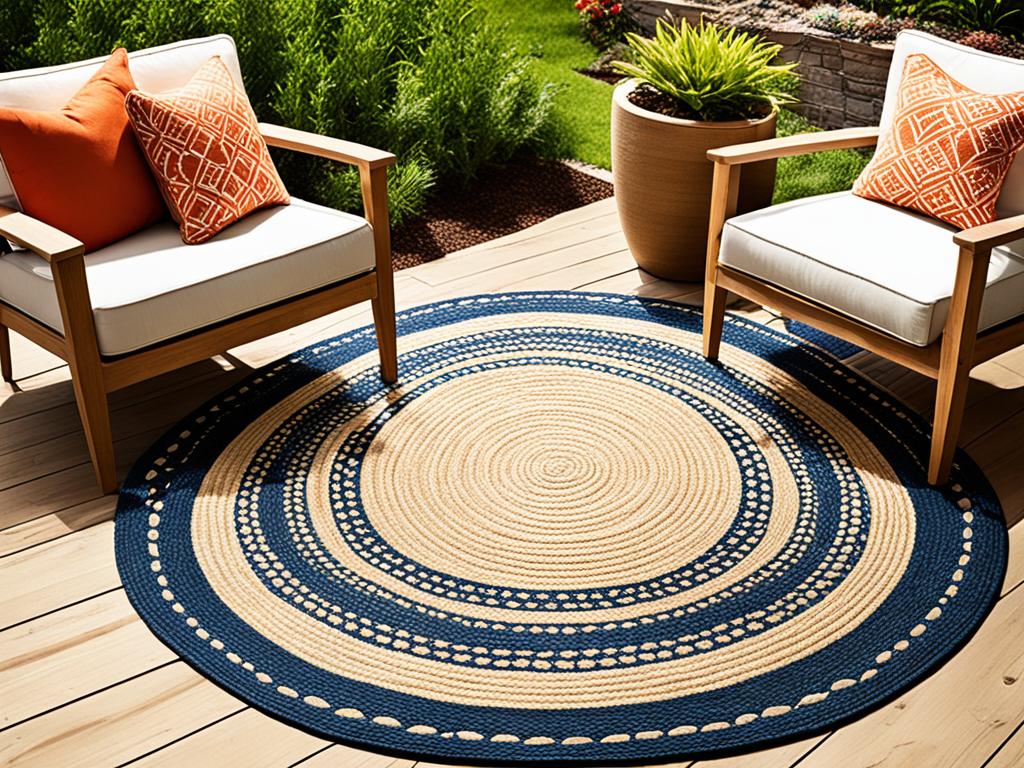
By taking the necessary precautions and providing proper care, you can enjoy the natural beauty of jute rugs in your outdoor spaces. Just remember to place them in covered areas, protect them from excessive moisture, and clean them regularly to maintain their integrity and longevity.
Conclusion
After exploring the outdoor durability of jute rugs, it is clear that while they can be used outdoors, careful consideration is needed. Jute rugs are best suited for covered areas or dry climates where they can bring a touch of natural warmth and style to your patio or outdoor space. Their affordability and eco-friendliness make them an attractive choice for those seeking a sustainable option.
However, in areas exposed to rain or high humidity, it is advisable to consider alternative natural fiber rugs like seagrass or sisal. These rugs offer similar durability and can better withstand wet conditions without the risk of mold, mildew, or deterioration. By choosing the right rug that matches the specific conditions and needs of your outdoor area, you can ensure its longevity and maintain its beauty for years to come.
So, before you decide to use a jute rug for your patio or outdoor space, take into account the climate and level of exposure to moisture. Always remember to provide proper maintenance, protecting your jute rug from rain, excessive humidity, and direct sunlight. By doing so, you can enjoy the natural allure of jute while prolonging the lifespan of your outdoor rug.
